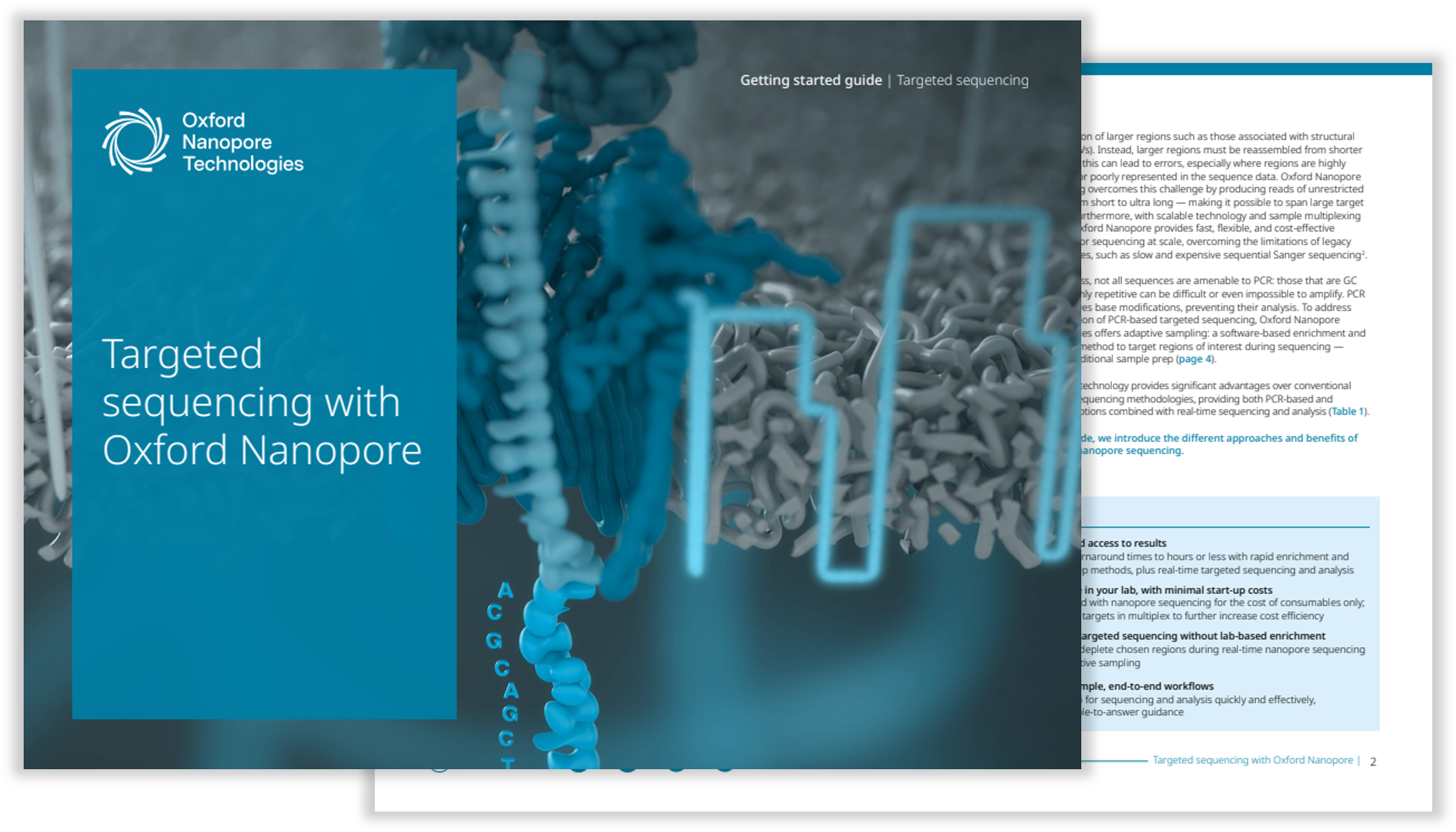Targeted sequencing
'The capacity to obtain haplotype-resolved DNA methylation profiles, in addition to STR size and interruption status, all in a single, simple assay is a clear advantage'
Stevanovski, I. et al. Sci. Adv. (2022)
Expand your targeted sequencing assays: fully characterise SNVs, SVs, repeats, epigenetic modifications, and haplotypes
Utilise amplicon sequencing, hybridisation capture, or on-device targeting using adaptive sampling
Analyse data in real time for immediate access to results
Expand the capabilities of your targeted sequencing assays
Enabling the generation of any length of sequencing read — from short to ultra long (50 bp to >4 Mb) — Oxford Nanopore technology expands the capabilities of targeted sequencing approaches beyond the analysis of single nucleotide variants (SNVs), to include high-coverage characterisation and phasing of structural variants (SV), repetitive regions, and base modifications.
Real-time data analysis provides faster access to results and underpins adaptive sampling — a unique on-device enrichment methodology that requires no additional wet-lab prep.
Featured content

A guide to targeted sequencing with Oxford Nanopore
Combining innovative enrichment methods with real-time sequencing, nanopore technology provides significant advantages over conventional targeted sequencing methodologies. Taking you from sample to answer, this guide provides best-practice recommendations for targeted nanopore sequencing.
Full-length 16S and ITS amplicon sequencing
Discover how Oxford Nanopore reads of unrestricted length deliver enhanced taxonomic resolution of your microbial samples. This workflow overview provides best-practice recommendations for streamlined 16S and ITS sequencing, from sample to answer.
Recommended device for targeted sequencing
)
GridION
The flexible GridION enables sequencing on up to five individually addressable MinION Flow Cells, for scalable, on-demand targeted sequencing of single targets or larger panels, with PCR-based strategies or PCR-free adaptive sampling.
Technology comparison
Oxford Nanopore sequencing
Legacy short-read sequencing
Any read length (50 bp to >4 Mb)
Short read length (<300 bp)
- Generate complete, high-quality genomes with fewer contigs and simplify de novo assembly
- Resolve genomic regions inaccessible to short reads, including complex structural variants (SVs) and repeats
- Analyse long-range haplotypes, accurately phase single nucleotide variants (SNVs) and base modifications, and identify parent-of-origin effects
- Sequence short DNA fragments, such as amplicons and cell-free DNA (cfDNA)
- Sequence and quantify full-length transcripts to annotate genomes, fully characterise isoforms, and analyse gene expression — including at single-cell resolution
- Resolve mobile genetic elements — including plasmids and transposons — to generate critical genomic insights
- Enhance taxonomic resolution using full-length reads of informative loci, such as the entire 16S gene
- Assembly contiguity is reduced and complex computational analyses are required to infer results
- Complex genomic regions such as SVs and repeat elements typically cannot be sequenced in single reads (e.g. transposons, gene duplications, and prophage sequences)
- Transcript analysis is limited to gene-level expression data
- Important genetic information is missed
Direct sequencing of native DNA/RNA
Amplification required
- Eliminate amplification- and GC-bias, along with read length limitations, and access genomic regions that are difficult to amplify
- Detect epigenetic modifications, such as methylation, as standard — no additional, time-consuming sample prep required
- Create cost-effective, amplification-free, targeted panels with adaptive sampling to detect SVs, repeats, SNVs, and methylation in a single assay
- Amplification is often required and can introduce bias
- Base modifications are removed, necessitating additional sample prep, sequencing runs, and expense
- Uniformity of coverage is reduced, resulting in assembly gaps
Real-time data streaming
Fixed run time with bulk data delivery
- Analyse data as it is generated for immediate access to actionable results
- Stop sequencing when sufficient data is obtained — wash and reuse flow cell
- Combine real-time data streaming with intuitive, real-time EPI2ME data analysis workflows for deeper insights
- Time to result is increased
- Workflow errors cannot be identified until it is too late
- Additional complexities of handling large volumes of bulk data
Accessible and affordable sequencing
Constrained to centralised labs
- Sequence on demand with flexible end-to-end workflows that suit your throughput needs
- Sequence at sample source, even in the most extreme or remote environments, with the portable MinION device — minimise potential sample degradation caused by storage and shipping
- Scale up with modular GridION and PromethION devices — suitable for high-output, high-throughput sequencing to generate ultra-rich data
- Sequence as and when needed using low-cost, independently addressable flow cells — no sample batching needed
- Use sample barcodes to multiplex samples on a single flow cell
- Bulky, expensive devices that require substantial site infrastructure — use is restricted to well-resourced, centralised locations, limiting global accessibility
- High sample batching is required for optimal efficiency, delaying time to results
Streamlined, automatable workflows
Laborious workflows
- Prepare samples in as little as 10 minutes, including multiplexing
- Use end-to-end whole-genome, metagenomic, targeted (including 16S barcoding), direct RNA and cDNA sequencing workflows
- Scale and automate your workflows to suit your sequencing needs
- Perform real-time enrichment of single targets or panels without additional wet-lab prep by using adaptive sampling
- Lengthy sample prep is required
- Long sequencing run times
- Workflow efficiency is reduced, and time to result is increased
)








